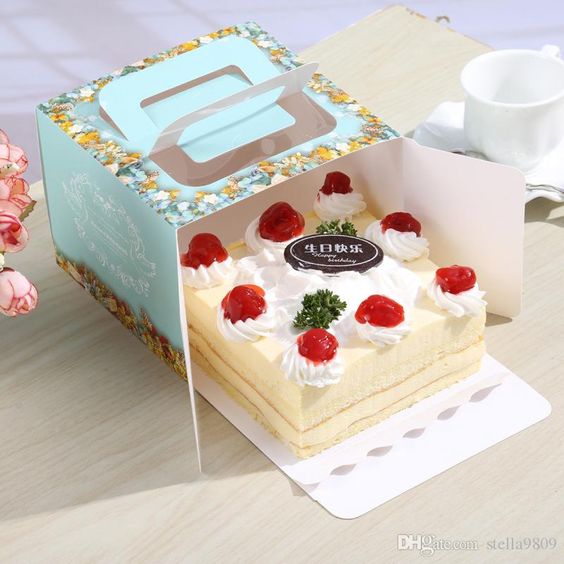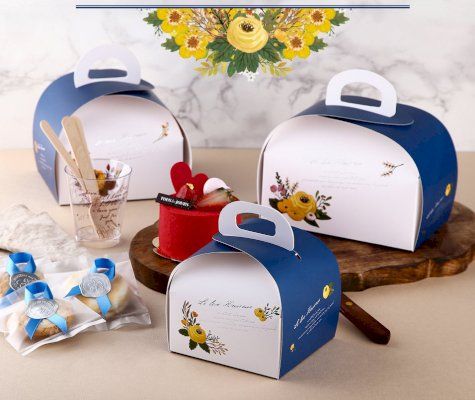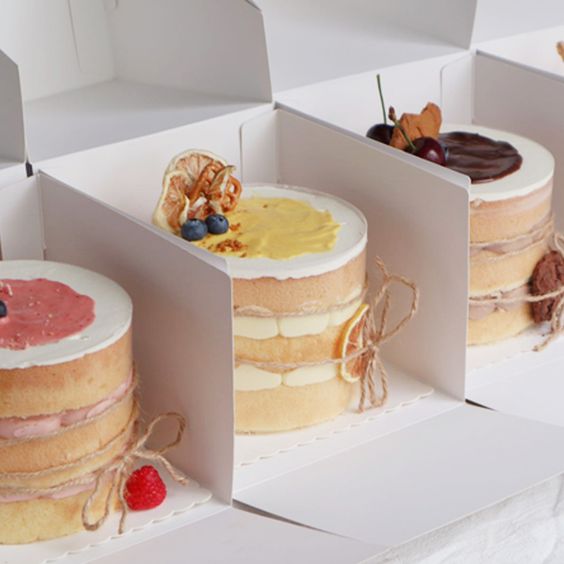Physical factors affecting the wholesale packaging process for custom cupcake boxes wholesale
Physical factors mainly refer to the impact of the product on its shape during its life cycle. The physical protection function of packaging custom cupcake boxes wholesale is to apply certain technical methods to protect the safe movement of products in the process of loading and unloading, storage and transportation, so that the products can reach their destination smoothly or complete the use of the function. Therefore, it is necessary to carefully analyze the physical and mechanical properties of the product, obtain protection requirements and detailed product information, as well as mechanical environmental conditions and damage before adopting technological methods for wholesale packaging of custom cupcake boxes. Packaging of products.
The purpose and role of the analysis of physical and mechanical properties of products includes three aspects: d to develop targeted and feasible packaging technology methods; @ to achieve packaging standardization, so that products with the same properties use the same packaging technology methods; diversification of packaging materials, reduction of packaging operations and handling costs, reducing packaging and transportation costs. The analysis of physical and mechanical properties and characteristics of products has many contents, such as the composition of product materials, physical properties of products, standard products, specialty products and so on.
1.the material composition characteristics of wholesale products of customized cupcake boxes

The material composition characteristics of the product belong to the natural characteristics of the product, and the packaging designer must first consider the characteristics of the product. The different materials in the external environment under the influence of damage caused by physical, chemical, climatic or biological factors, the deterioration mechanism is different, and the damage to the packaging product caused by damage to the external environment is also different. At the same time, the diversity of product materials makes it complicated to select cleaning products, protective agents, inner packaging materials, cushioning materials and outer packaging materials.
Genre. Packaging designers therefore need to know the damage and degradation mechanisms of the different materials and commonly used protection techniques and apply this basic theoretical knowledge to packaging design.
2. Wholesale customized cupcake boxes Physical properties of products.

Know the physical properties of the products, design the packaging to meet product protection requirements and some specific application requirements. The basic properties of the product can be divided into chemical sensitivity, physical sensitivity, sensitivity to resistance, material compatibility, structural properties, size and quality, removability, load type, product cost and so on. 1, Physical sensitivity to shock, vibration and other external influences Friction can cause physical damage or malfunction of the product. From the packaging perspective, the analysis of the physical fragility of the product mainly refers to shock, vibration and other factors.
Damage, radiation field, electromagnetic field, electrostatic field and other external fields can damage the product.
(1) Surface roughness requires strict protection of the surface of the finished product, waterproof surface, optical mirror surface
(2) Shock and vibration from the point of view of the shock absorber
Protection, custom cupcake boxes Wholesale packaging designers must fully understand the characteristics of the product, including shape, size and location of the center of gravity, mass and inertia with respect to the three-dimensional axis, transportability, pressure position, attachment points and lifting positions, fragility value, natural frequency, etc.
The fragility value, also known as brittleness, is the maximum acceleration value that a product can withstand without causing physical or functional damage and is generally expressed as a multiple of the acceleration of gravity, G. The fragility value is also known as brittleness. Table 2-1 in the US military standard MIL HDBK 304 indicates the fragility value of a product
The higher the product's brittleness value, the greater its ability to resist external forces, which must be carefully taken into account during design. The allowable brittleness value [G is the allowable acceleration value of the product, specified on the basis of factors such as the value, strength and importance of the product, which is less than or equal to the standardized brittleness value. When designing shock-absorbing packaging, the maximum amplitude of product acceleration must be less than the permissible fragility value.
(3) The intensity of the external field can cause severe damage to special products, and even serious accidents.
For special products such as hazardous goods, precision electronics and other high-tech products, designers of wholesale packaging for customized cupcake boxes must fully understand their sensitivity to external field strength and take effective protective measures for the packaging.
3. strength and fragility

Strength refers to a product's ability to resist excessive deformation or breakage. The strength and fragility of the product determine the requirements and degree of protection of the packaging. In terms of strength and fragility, products can be divided into three categories: fragile products, precision products and resistant products, and resistant products can be divided into flexible resistant products and rigid resistant products. Fragile and precision products are the main focus of shock absorber protection.
Compatibility between materials and products, and compatibility between different packaging materials, are fundamental to product packaging.
Material compatibility Many packaging materials (including cushioning materials) are in direct contact with the product, and the physical properties of the two materials must be compatible to avoid the physical effect that alcohol often has. In addition, many cushioning materials generate static electricity when subjected to shock and vibration, or when customized cupcake boxes are bulk-packed to avoid friction with metallic materials. When these electrostatic charges build up to a certain point, they cannot produce sparks and may also attract dust or other substances.
4. structural features and disassembly points determine how the product is fixed and supported, as well as the type and quantity of cushions in the packaging box.

Convex parts and sharp corners of the product require special protection, and their dimensions, mass and distribution, center of gravity, etc. not only influence the selection and design of the wholesale packaging container for custom cupcake boxes, but also lead to difficulties in protecting the packaging. In addition, to facilitate packing, storage and transport, it is sometimes necessary to separate the product for packing and transport. Close cooperation and coordination between product designers and designers of wholesale packaging for customized cupcake boxes helps to resolve these difficulties. Before designing packaging for mobile products, packaging designers need to know whether the location where the product will be used has the necessary tools, equipment and technical capacity for production assembly.
5. Load type of wholesale personalized cupcake boxes
Load type refers to the distribution of load on the packaged product, which is generated when the product is packaged. According to the load type, products can be divided into three categories: easy to load, difficult to load and medium load. Easy-to-load products are called easy-to-load products. They have a uniform density distribution, standardized sizes and are easy to pack. Typically, inner, outer and pallet packaging are used. The center of gravity of the packaged product is at the geometric center of the packaging container. Difficult-to-load products are referred to as difficult-to-load products if the density distribution is uneven, and products with irregular sizes cannot completely fill the packaging container or do not have a defined support surface in the packaging container. If special support and positioning technology is not used in the packaging design, stress concentrations can occur during loading, unloading and transportation, which can damage the packaging. The center of gravity of products that are difficult to load after packaging is usually not in the geometric center of the packaging container, and the packaging container must be marked with a center of gravity icon during storage and transportation in accordance with regulations to ensure safe loading, unloading and handling. Medium-weight goods are between easy-to-load and difficult-to-load goods, such as cans and bottled beverages.
6. Product cost for wholesale personalized cupcake boxes
Product cost is an important design parameter for packaging designers to consider. On the one hand, packaging designers need to use the lowest packaging cost to meet product protection requirements; on the other hand, if a key or essential product component is damaged, it may result in greater product loss, and product cost will no longer be the most important factor.... Read more
standard and customized products of To maximize standardization of packaging, products should be categorized by physical characteristics. Products with the same or similar physical and chemical characteristics as categorized products are called standard products, and these new products are usually packaged according to existing conventional custom cupcake box packaging methods. Products that do not have the same or similar physical and chemical properties as categorized products are called custom products, and these products must be packaged before packaging, and detailed drawings and packaging materials must be provided.
Wholesale customized special products in Special products mainly include dangerous goods and microelectronic products
1. dangerous goods
Products that are explosive, flammable, toxic, radioactive, etc., and can easily cause accidents and property damage during transportation, loading, unloading and storage, and require special protection, are called dangerous goods. The national standard CB6944 "Classification and Labeling of Dangerous Goods" divides dangerous goods into nine categories.
The main purpose of packaging dangerous goods is to prevent damage that may occur during the loading, unloading, transportation, storage and use of dangerous goods. The complexity of the nature of dangerous goods themselves and the variety of external environmental factors. Gunpowder, for example, may consist of a variety of substances, some of which are harmful to the environment. Some are sensitive to shock, some to friction, and some to light, heat, static electricity, etc. During loading, unloading, transportation and storage, various risk factors may appear among the environmental factors, which creates great difficulties in packaging dangerous goods. Various types of ammunition, gunpowder and pyrotechnics in the defense industry are flammable and explosive dangerous goods. Such packaging must not only guarantee the safety of the product, but also ensure reliable long-term storage, adaptability to movement and ease of use of the product. Packaging for the export of dangerous goods must comply with the "Regulations for the International Carriage of Dangerous Goods by Sea" issued by the International Maritime Organization.
Preservation.
2.Microelectronics products
Microelectronics are specialized products such as various large-scale integrated circuit components, integrated circuit boards and certain precision optical-mechanical and electrical integration products. They are not only sensitive to moisture and rust, but also to shock and vibration. They are also extremely sensitive to external influences. Risks associated with field strength. Shielding and protection against electromagnetic fields, electrostatic fields and radiation fields are extremely important for the performance and service life of these products. Component protection is an important measure to ensure the reliability and lifetime of the whole device, and this protection must be complete and reliable. Throughout the product process, from the components to the assembly into components or parts and the assembly of components into products, any negligence in the protection of the packaging can have serious consequences and result in relatively large losses.
The electrostatic discharge sensitivity of some commonly used electronic products is shown in Table 2-3. Sensitivity to static electricity refers to the degree to which a product is damaged by static electricity. The extent of the electrostatic hazard, or the severity of electrostatic damage, depends on the degree of static build-up (electrostatic voltage) and the electrostatic susceptibility of the product to electrostatic discharge. The higher the electrostatic voltage, the greater the damage. The higher the electrostatic susceptibility of the product, the greater its susceptibility to electrostatic damage.
A packaged product only changes its physical properties during the circulation process, without creating new substances. Changes in density, color, gloss, odor, aging, sublimation, volatilization, decomposition, melting point, boiling energy, plasticity, thermal conductivity, electrical conductivity, optical properties, etc. can all be measured. All this can be measured by human senses such as the tongue, tongue and body, or by experimental instruments. Before and after physical changes are made to packaged products, the type and nature of the packaged products are not determined. Here, we mainly present the three-state changes of customized wholesale cupcake boxes, infiltration and seepage, thermal conductivity and mechanization of attached heat, changes in electromagnetic and optical properties, as well as mechanical changes (forces), etc.
The phenomenon of product dissolution is linked to hygroscopicity, water solubility and hygroscopic point. Hygroscopicity represents a product's ability to absorb and release moisture, which affects its physical properties, such as water barrier properties, curling properties and bubble formation. Water solubility represents the property of molds to dissolve in absorbed water and become a liquid. The hygroscopic point designates the relative humidity value at which a product begins to absorb moisture under certain temperature and pressure conditions. If the pressure is constant, as the ambient temperature rises, the hygroscopic point gradually decreases, making it easier for the product to absorb moisture and melt. Although some products, such as potassium sulfate, potassium perchlorate, etc., have excellent water solubility, their absorption properties are very weak, so they are not easy to dissolve under normal temperature and pressure conditions. There are also certain products, such as leather, paper, cotton, sponge, brick glue, etc., which, despite having a high hygroscopicity, are not soluble in water and therefore do not melt. Consequently, it is only when a product has high hygroscopicity and good water solubility that it can be gradually dissolved in a humid environment and finally completely dissolved in a liquid. The relative humidity of the air has a very important effect on the product's degree of melting. If relative humidity is too low, even easily soluble products with high hygroscopicity and water-bath properties are not easy to dissolve, and conditions of very low relative humidity, such as dry deserts, do not allow the product to dissolve.
Post time: Sep-12-2023


-4.jpg)
